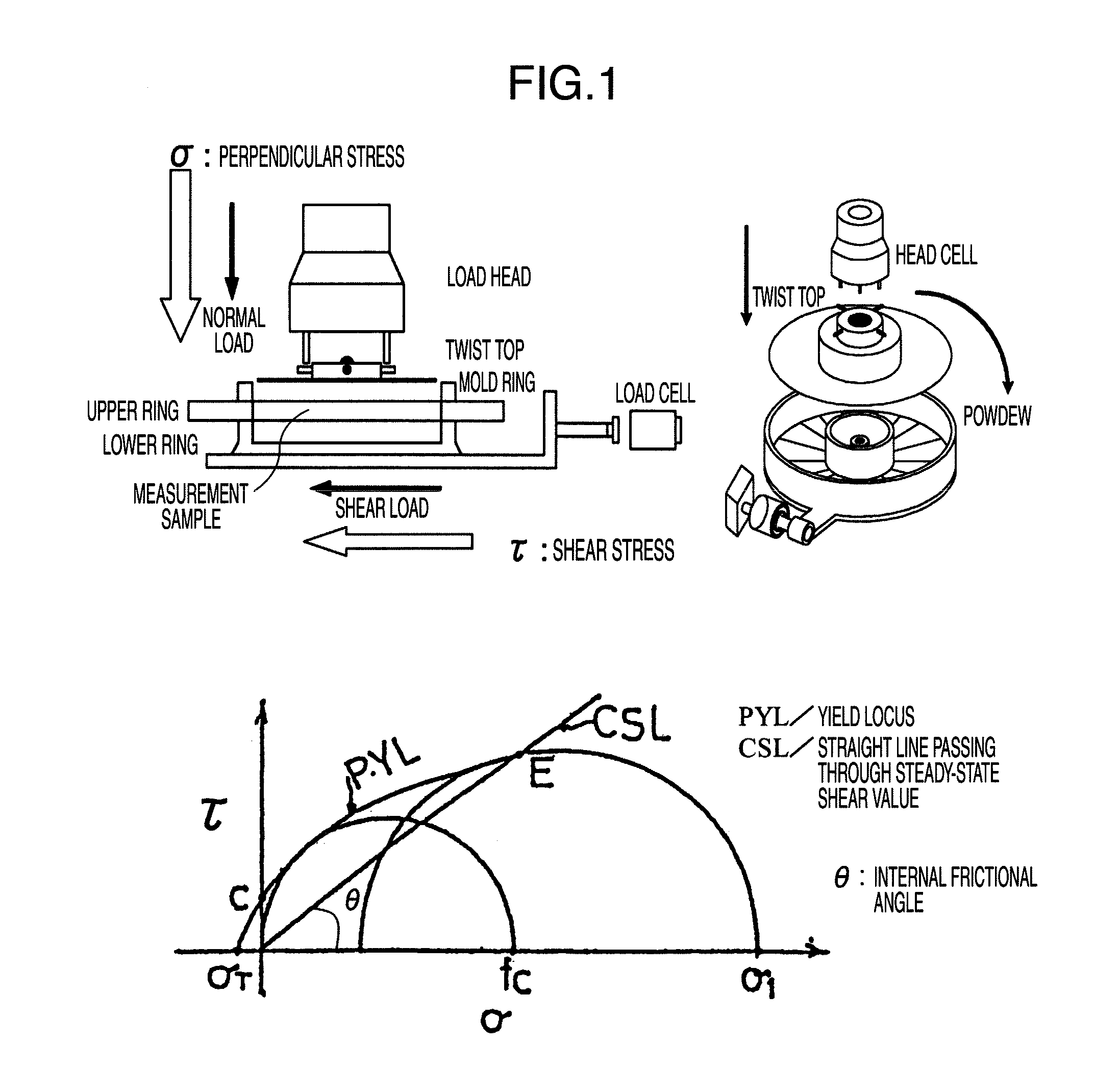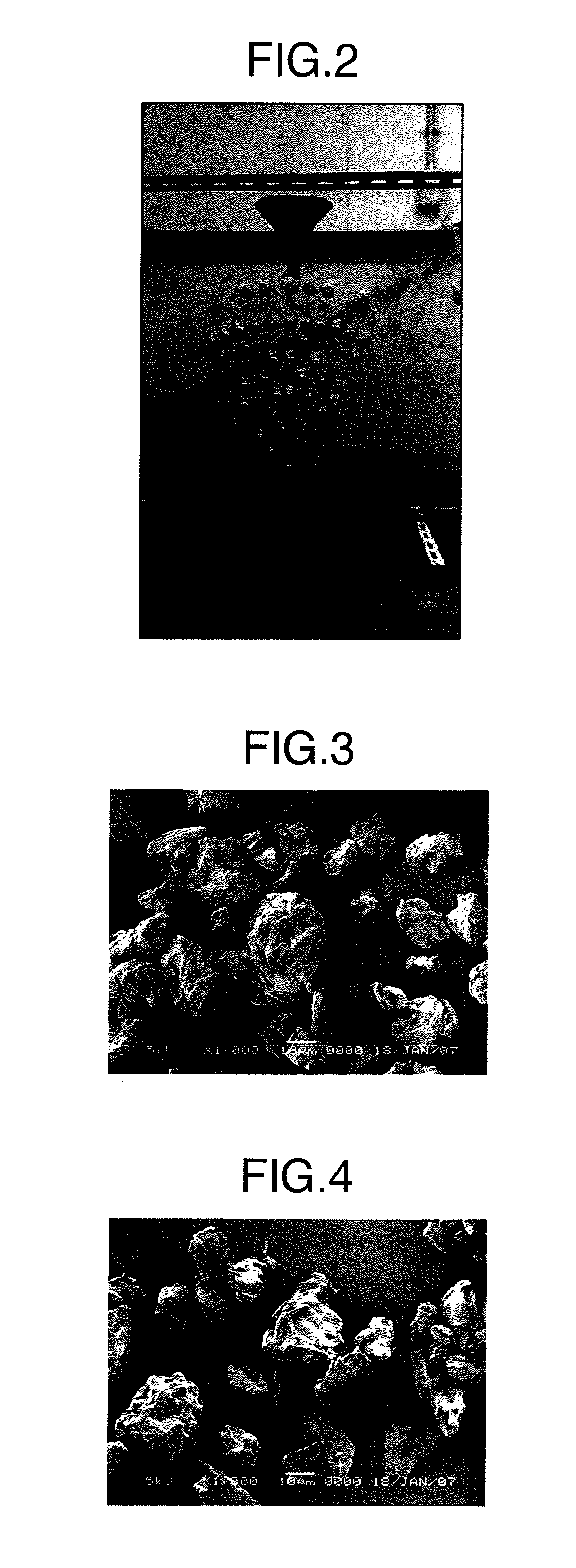Cellulose powder having excellent segregation preventive effect, and compositions thereof
- Summary
- Abstract
- Description
- Claims
- Application Information
AI Technical Summary
Benefits of technology
Problems solved by technology
Method used
Image
Examples
example 1
[0111]In a low-speed stirrer (from 30LGL reactor (trade name) from Ikebukuro Horo Kogyo Co., Ltd.), 2 kg of a chipped product of a dissolving pulp (19 μm in width and 3 μm in thickness from a broad leaf tree) and 30 L of a 10% hydrochloric acid aqueous solution were placed and hydrolyzed at 105° C. for 30 minutes while stirring to provide an acid-insoluble residue. The resultant acid-insoluble residue was well washed with pure water and then filtered to provide a wet flock (the average particle size of cellulose dispersion particles in this acid insoluble residue was 9.0 μm). The wet flock was introduced into a 90-L plastic bucket and pure water was then added thereto so as to provide a solid content concentration of 6% by weight, followed by neutralization with aqueous ammonia while stirring with a 3-1 motor (pH after neutralization was 7.5 to 8.0). The resultant cellulose dispersion was spray-dried (dispersion supply rate: 6 kg / hr, inlet temperature: 180 to 220° C., outlet tempera...
example 2
[0112]In a low-speed stirrer (from 30LGL reactor (trade name) from Ikebukuro Horo Kogyo Co., Ltd.), 2 kg of a chipped product of a dissolving pulp (19 μm in width and 3 μm in thickness from a broad leaf tree) and 30 L of a 4N hydrochloric acid aqueous solution were placed and hydrolyzed at 40° C. for 48 hours while stirring to provide an acid-insoluble residue. The resultant acid-insoluble residue was well washed with pure water and then filtered to provide a wet flock. The wet flock was introduced into a 90-L plastic bucket and pure water was then added thereto so as to provide a solid content concentration of 4% by weight, followed by neutralization with aqueous ammonia while stirring with a 3-1 motor (pH after neutralization was 7.5 to 8.0) and quadruple treamtments at 70 MPa using a high-pressure homogenizer (RANNIE5-10.38 (trade name) from APV) (The average particle size of cellulose dispersion particles in this acid insoluble residue was 8.1 μm). This was spray-dried (dispersi...
example 3
[0113]In a low-speed stirrer (from 30LGL reactor (trade name) from Ikebukuro Horo Kogyo Co., Ltd.), 2 kg of a chipped product of a dissolving pulp (19 μm in width and 3 μm in thickness from a broad leaf tree) and 30 L of a 4N hydrochloric acid aqueous solution were placed and hydrolyzed at 40° C. for 48 hours while stirring to provide an acid-insoluble residue. The resultant acid-insoluble residue was well washed with pure water and then filtered to provide a wet flock. The wet flock was introduced into a 90-L plastic bucket and pure water was then added theretoso as to provide a solid content concentration of 2% by weight, followed by neutralization with aqueous ammonia while stirring with a 3-1 motor (pH after neutralization was 7.5 to 8.0) and octuple treatments at 70 MPa using a high-pressure homogenizer (RANNIE5-10.38 (trade name) from APV) (The average particle size of cellulose dispersion particles in this acid insoluble residue was 6.9 μm.) This was spray-dried (dispersion s...
PUM
| Property | Measurement | Unit |
|---|---|---|
| Length | aaaaa | aaaaa |
| Percent by mass | aaaaa | aaaaa |
| Percent by mass | aaaaa | aaaaa |
Abstract
Description
Claims
Application Information
 Login to View More
Login to View More - R&D
- Intellectual Property
- Life Sciences
- Materials
- Tech Scout
- Unparalleled Data Quality
- Higher Quality Content
- 60% Fewer Hallucinations
Browse by: Latest US Patents, China's latest patents, Technical Efficacy Thesaurus, Application Domain, Technology Topic, Popular Technical Reports.
© 2025 PatSnap. All rights reserved.Legal|Privacy policy|Modern Slavery Act Transparency Statement|Sitemap|About US| Contact US: help@patsnap.com



